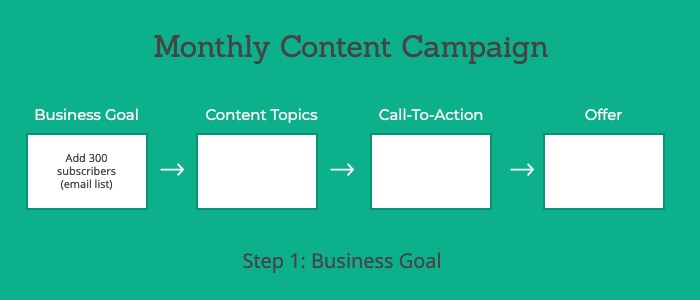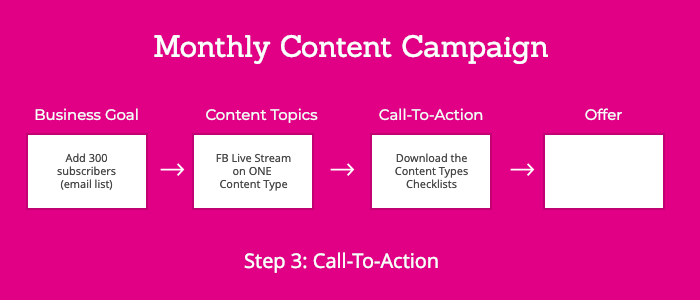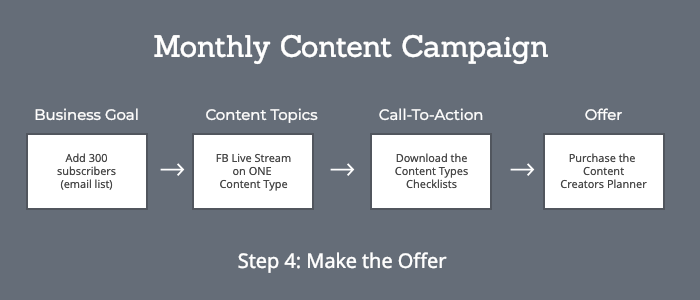
The great thing about creating a content strategy for 2020 is that it’s going to work for the long-term.
Naturally, there will be content that is time-sensitive or specific to an event, so it doesn’t need to be created with a long-term plan in mind, it just needs to support your brand and overall business goals.
There are two elements to creating a content strategy that sells:
- Creating content that your audience wants
- Creating content that supports your business goals and drives sales
Ideally, these are one and the same.
But they don’t always have to be.
It’s perfectly O.K. to create content that you want to create, regardless of whether or not it has a direct link to a definable end business goal.
Your content should also connect with your audience. Sometimes personal thought pieces do more than the most well-written, optimized post you could write.
The one thing most people won’t tell you about creating a content strategy that sells is that it never ends. It’s not set-and-forget, no matter how many marketers tell you that you can blitz through and create content for the year in only 3 days with short, quippy videos that get repurposed twelve ways sideways (can you tell we’re not huge fans of this process?).
The truth is, you can probably reach your audience on most platforms these days, so start with creating content you want to be creating and do it in a way that serves your business… NOT social platforms. I’m writing this post a couple of days after Facebook had a massive outage (although it didn’t completely go down, it was just broken) and I’m blown away by how many people still create content on social platforms first. It’s perfectly fine to create some original content on social platforms, but your best content should exist on your site first. Facebook lost 50 million the day it broke (according to MobileMonkey). They are a for-profit company and it’s in their best interest to get you to pay-to-play.
Share your content on these platforms but for all that is good in the world, do not use social in lieu of your own branded website.
The algorithms of the social platforms don’t work the same way the search engines do. The search engines are getting smarter and they can tell the intent behind why someone is searching, which goes way beyond keywords. If you want a better understanding of this, check out my friend Brendan Hufford’s article “Why Ranking for SEO ‘Trophy Keywords’ is a Colossal Waste of Time”.
The article focuses on the SEO niche, but if any niche gets this it’s SEO.
Let’s jump into creating your content strategy.
Your content strategy will grow and evolve as you gather more data and your conversions increase.
To quote Seth Godin, “Content marketing is the only marketing left.”
Let’s dive in!
There are a handful of ways you can start with creating your content strategy, but we’re going to start with your business goals.
Once you have content converting that supports your business goals then you can jump in and write a rant post, share a vulnerable moment, or make a silly video.
Deal?
We’re going to approach this from a 90-day content strategy, so this isn’t about the BIG picture (ex: your revenue goal for the year). I’m going to break this down into manageable 90-day sprints, starting with the plan for the month.
The four areas we’re going to start with for our content strategy are:
- Business goal
- Content topics
- Call to action
- Offer

Start with your business goal:
To make things easier, I’ll use our own product for this content strategy (which is the Content Creators Planner).
So for our 90-day content strategy, we’ll create 1-3 business goals, but I’ll focus on one for the sake of this post.
Business goals (these are for one month):
- Add 300 new email subscribers
- Sell 100 planners
- Get on 5 podcasts
With those business goals in mind, I’ll then decide what content topics I’ll create that supports those business goals.
Side note: This process is assuming you know who your audience is and what their problem is. We’re not huge fans of the whole ‘create your buyer persona’ demographic exercises… if you want to learn how to define who your ideal customer is, listen to this podcast interview with Michelle Hunter.
For the sake of this post and want to give you something visual, we’re going to follow through with one element of each of the four sections to give you a complete picture. So in the case of the business goal, let’s focus on ‘adding 300 new subscribers. The image below shows this flow and our choice in focusing on the new email subscribers.

Select Your Content Topics
Now that I have my business goals in mind, I’ll decide what topics I’m going to create content on that support reaching my business goals.
- What type of content will best serve my audience?
- What type of content do I enjoy creating?
- What other types of content are already published on the same topic?
First I’m going to list a few content types, then will decide which content types will best serve my business goals. Note that the business goal of adding 300 new email subscribers also supports the business goal of selling 100 planners, either through direct traffic to the website or a follow-up sequence sent to our new email subscribers. The goal of getting on 5 podcasts is an independent goal that can indirectly support the first two business goals.
What content topics and types will best serve my audience?
Since we’re targeting people who aren’t currently subscribers, whatever topic we choose needs to accomplish a few things:
- High quality: since this might be the first time someone is interacting with our brand, the content should be high quality (ideally it all is, but not everything you publish needs to be epic)
- Solve a definitive problem that can then be applied to our call-t0-action and offer.
- Example: Since we teach and support content marketing, it might make sense to do an in-depth post on how to use ‘Stories’ (think Instagram stories, Facebook stories, AMP stories) in your marketing. This post could have screenshots, a few videos, and a list of relevant tools and resources. Doing this type of post is on-point with our end goal of selling the planner because we talk about using stories as a content type and including them as micro-content.
- Make a connection with our potential subscriber: we want this post to instill trust and authority
My list of potential topics and content types that I would then list in the second box of the Monthy Content Campaign:
- How to use Stories in your marketing: written & video
- Case study podcast with a customer: who they are, how they’re using the planner, sharing results
- Live stream: live stream of ONE of the Content Types from the Content Types Checklist
NOTICE:
With each of the potential topics, I’ve got multiple pieces of micro-content that I can then create from each of these (the post on using Stories: I could do a podcast on this, interview some of the creators of the tools and resources, share the individual videos from the post, etc.).
In this case, I’m going to go with the 3rd option. My choice in doing this is that it’s the most congruent type of content that supports the lead magnet offer (our call-to-action), which is the Content Types Checklist. After the live stream, I’ll repurpose the video for a blog post, our YouTube Channel, and plenty of social sharing images with links back to the original post. I’ll structure the live stream in a way that it will be easy to duplicate with the 7 other content types from the checklist (thus giving me 8 separate live streams… you can see where this is starting to get massive with the amount of content I can create, provided it’s done well). I’ll also record the process from start to finish so I can create a process to hand off to someone else for future live streams.
Here’s what our Monthly Content Campaign looks like now:

Define Your Call-to-Action
You want to think of your call to action as your precursor to your offer.
I know this sounds obvious, but often times people miss connecting the dots on this one. This doesn’t mean you need to have tons of different calls to action for all your content (there are many schools of thought on this, but I think it can overcomplicate things. You can have one call to action and different follow-up sequences that differentiate the path for your subscribers based on where they opted in, or what they’ve clicked in the follow-up sequence).
A call to action doesn’t always have to be an email optin for a lead magnet, but ideally, you’re going to get the email address at some point (think webinar registration, messenger optin, etc.).
Based on the examples above, here are a few calls to action I might use:
- Download the Content Types Checklist
- Register for a free training via Messenger (we will capture the email address in the follow-up sequence in Messenger)
- Register for a live webinar (using Messenger or email)
We’re working on a few different types of lead magnets that we’ll be testing (including printing the Content Types Checklist that we’ll do a free+ shipping offer for), but for now, we’re using what we have (don’t overcomplicate this).
Once they’ve downloaded the Content Types Checklist, they’ll get a follow-up email sequence which will eventually lead to an offer to purchase the planner.
Here’s what our Monthly Content Campaign looks like now:

Define the Offer / End Goal
This is where the rubber meets the road, right?
The content goals you created in step should be in complete alignment with your offer. The reason we’ve also included ‘end goal’ is that some offers may have a longer closing process (anything that might be considered ‘high ticket’ – coaching, mastermind, done-for-you service, etc. that include a more personal touch and phone conversation. The end goal, in this case, might be simply to get someone on a call/strategy session).
Although it might seem obvious that our offer is the planner, we’re going to be testing a couple different models to sell the planner.
Here is what our two offers would be:
- Individual planner purchase (either single or subscription)
- Content Course with planners included (sell the course, give an annual subscription with the course)
Both are in alignment with our end goal: sell planners
In this specific Monthly Content Campaign (starting with our goal of getting 300 new email subscribers), I would focus on simply selling the planner (as opposed to the course + planner subscription).
The reason for this is that it will be completely automated. Once someone opts into our email list they’ll be sent a follow-up sequence that includes an offer at the end to purchase the planner. The follow-up sequence will be value-driven plus a little ‘getting to know you’ pieces of content (connect with us on social, link to a piece of content that teaches something, etc.).
Here’s what our Monthly Content Campaign looks like now:

The Monthly Content Campaign is the first piece of creating your content strategy.
This is very ‘tactical’ and gives you a step-by-step process for structuring this step, but there’s another piece (probably the most important piece) that is sort of ‘pre-strategy’.
Your actual content.
The message you’re wanting to convey, whether it’s telling a story, teaching how to do something, or connecting with your audience.
It might seem a little counter-intuitive to be sharing this at the end of this post, but sometimes it’s easier to have a process that allows you to ‘fill in the holes’ in order to decide what you’re going to create. Think of the good ol’ 5-paragraph essay that we’re taught early on in high school.
Writing an essay is much easier when you have a framework to use (here’s a crude explanation of the 5-paragraph essay):
- Create your thesis statement (and one paragraph that gives a general overview)
- Write 3 supporting statements (one paragraph each to support the thesis statement)
- Closing paragraph (one paragraph that ties it all together and drives home the thesis statement
You can see that once you have your thesis statement, you’ll have a much easier time working through the entire essay.
Creating content isn’t any different.
It doesn’t have to be written content either, no matter what type of content you’re creating you can create a framework that supports your overall business goals and provides massive value to your audience.

Thanks so much for mentioning me here! I totally agree that having a strong framework and strategy for your content strategy is essential.
Thanks, Brendan,
And you’re welcome 🙂 This is part 1 of this post 😉 I’m going to keep adding to it.
Interesting strategy. I always have trouble figuring out what exactly I need to produce.
Thanks, Jeremiah,
Creating content that supports your business goals is a great starting point, but it’s also invaluable to create content that connects with people on a personal level. Tell a story, a lesson learned, a rant… doing this creates a solid connection with your audience.